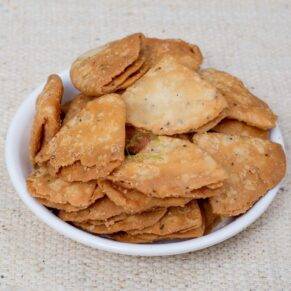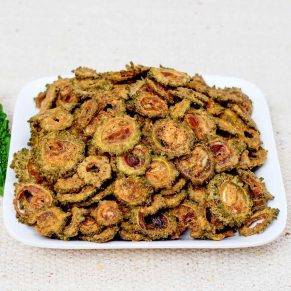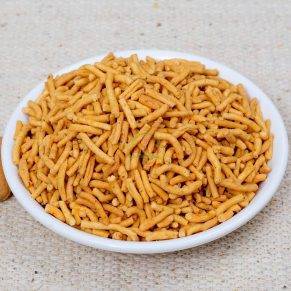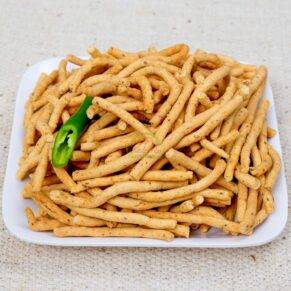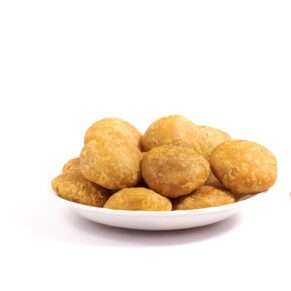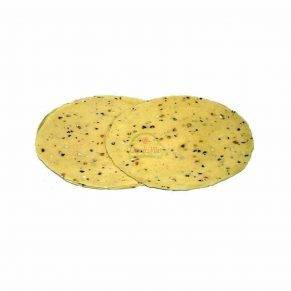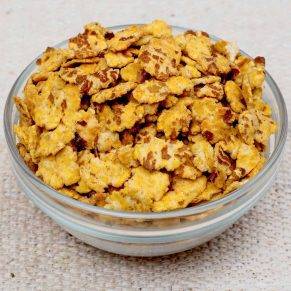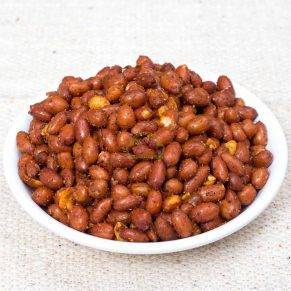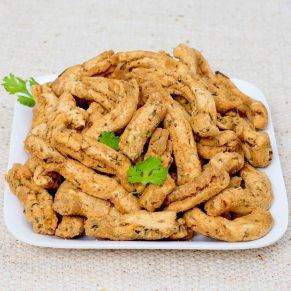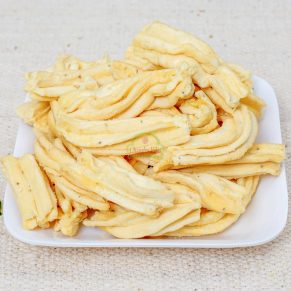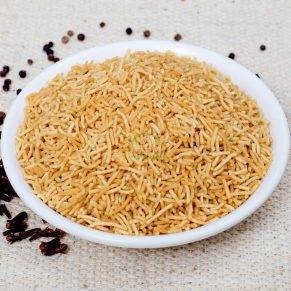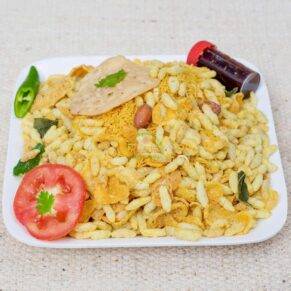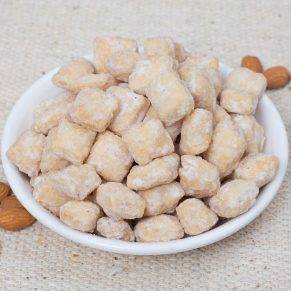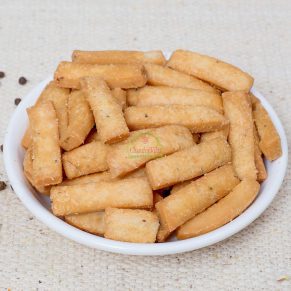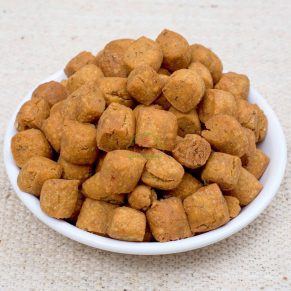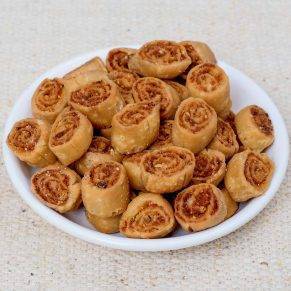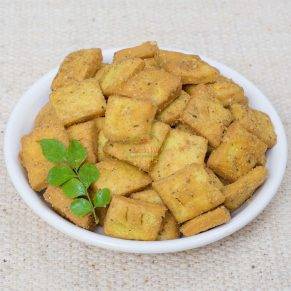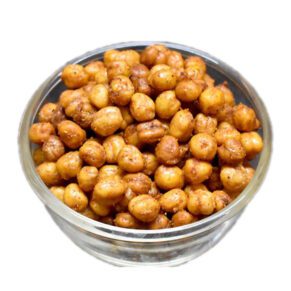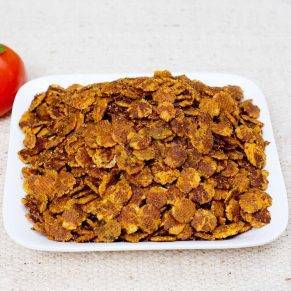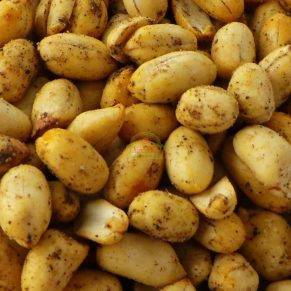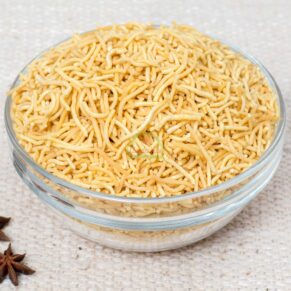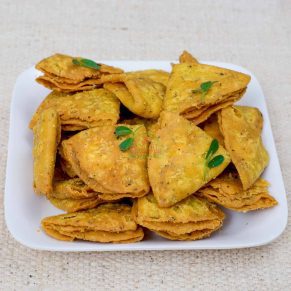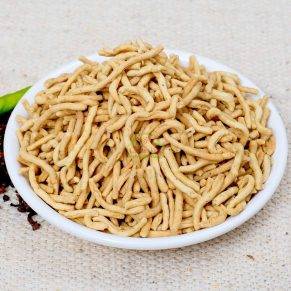- Your cart is empty
- Continue shopping
Jain - Without Onion Garlic
Traditional Dry Snacks, Namkeens, Mathri Without Onion Garlic
The culinary heritage of any culture is incomplete without its traditional dry snacks. These savory delights have been cherished for generations, offering a burst of flavors and textures. In this article, we will delve into the world of traditional dry snacks, with a specific focus on namkeens and mathri without onion and garlic. Let’s explore the delightful realm of these delectable treats that are loved by people of all ages and backgrounds.
| Table 1: Article Outline |
|---|
| 1. Introduction |
| 2. What are Traditional Dry Snacks? |
| 2.1 Origins and Cultural Significance |
| 2.2 Variety of Traditional Dry Snacks |
| 3. The Delightful World of Namkeens |
| 3.1 Popular Namkeens and Their Ingredients |
| 3.2 Health Benefits of Namkeens |
| 4. Exploring Mathri: A Classic Indian Snack |
| 4.1 Mathri: A Brief History |
| 4.2 Types of Mathri |
| 5. The Allure of Onion and Garlic in Snacks |
| 5.1 Traditional Snacks with Onion and Garlic |
| 5.2 Demand for Onion and Garlic-Free Snacks |
| 6. Enjoying Traditional Dry Snacks Without Onion and Garlic |
| 6.1 Innovative Flavors and Ingredients |
| 6.2 Recipes and Alternatives |
| 7. Conclusion |
| 8. FAQs |
Table 2: Article
1. Introduction
Dry snacks hold a special place in the hearts of food enthusiasts. They are not only a perfect accompaniment to tea or coffee but also a popular choice for munching during gatherings or as a quick snack on the go. Traditional dry snacks, particularly namkeens and mathri, have become an integral part of Indian cuisine and are enjoyed across the country.
2. What are Traditional Dry Snacks?
2.1 Origins and Cultural Significance
Traditional dry snacks have a rich history dating back centuries. They have evolved from regional specialties to national favorites, reflecting the diverse culinary traditions of India. These snacks have cultural significance and are often associated with festivals, celebrations, and special occasions.
2.2 Variety of Traditional Dry Snacks
The world of traditional dry snacks is incredibly diverse. It encompasses a wide range of treats made from various ingredients such as lentils, chickpea flour, rice flour, spices, and more. From crispy chaklis to crunchy sev, each snack has its unique flavor profile and preparation method.
3. The Delightful World of Namkeens
Namkeens are a prominent category of traditional dry snacks, loved for their irresistible taste and crunchy texture. Let’s explore why these savory treats have gained such popularity.
3.1 Popular Namkeens and Their Ingredients
Namkeens come in numerous flavors and forms. From the tangy aloo bhujia to the spicy masala peanuts, namkeens offer a wide variety of options to satisfy different taste preferences. These snacks are typically made using a combination of ingredients such as besan (gram flour), spices, nuts, and sometimes dried fruits.
3.2 Health Benefits of Namkeens
Contrary to popular belief, namkeens can be a healthier snacking choice when consumed in moderation. Many namkeens are low in fat, rich in protein, and contain essential nutrients. However, it’s important to choose namkeens that are prepared using quality ingredients and a controlled amount of oil.
4. Exploring Mathri: A Classic Indian Snack
Mathri is a traditional snack that holds a special place in Indian cuisine. Let’s take a closer look at its history, regional variations, and why it has become a beloved snack across the country.
4.1 Mathri: A Brief History
Mathri traces its roots back to the royal kitchens of Rajasthan. It was initially prepared as a travel-friendly snack that could last for weeks without losing its flavor. Over time, mathri gained popularity and spread to various parts of India, acquiring unique regional twists along the way.
4.2 Types of Mathri
Mathri comes in different shapes, sizes, and flavors. Some popular variations include plain mathri, masala mathri, and ajwain mathri. These snacks are made using a combination of flour, spices, and ghee, resulting in a crispy and addictive snack.
5. The Allure of Onion and Garlic in Snacks
Onion and garlic are staple ingredients in many traditional snacks, imparting a distinctive flavor and aroma. However, there is a growing demand for snacks without onion and garlic due to dietary restrictions, religious practices, or personal preferences.
5.1 Traditional Snacks with Onion and Garlic
Several popular traditional snacks, such as onion bhajis and garlic sev, rely heavily on the flavors of onion and garlic. These snacks are enjoyed by many, but for those looking to avoid these ingredients, alternative options are sought after.
5.2 Demand for Onion and Garlic-Free Snacks
The demand for snacks without onion and garlic has led to the development of innovative recipes and alternatives. Many snack manufacturers and home chefs are creating delectable treats that capture the essence of traditional snacks while omitting onion and garlic.
6. Enjoying Traditional Dry Snacks Without Onion and Garlic
Fortunately, it is possible to enjoy the flavors of traditional dry snacks without onion and garlic. Let’s explore some of the ways you can savor these snacks while adhering to your dietary preferences.
6.1 Innovative Flavors and Ingredients
Snack producers are introducing new flavors and ingredients to cater to those who avoid onion and garlic. You can find snacks infused with regional spices, herbs, and even tangy fruit flavors. These alternatives offer a delightful twist to traditional dry snacks.
6.2 Recipes and Alternatives
For those who enjoy cooking, there are numerous recipes available to create onion and garlic-free versions of traditional snacks at home. You can experiment with different flours, herbs, and spices to recreate the flavors you love.
7. Conclusion
Traditional dry snacks, such as namkeens and mathri, bring joy to countless individuals. They embody the culinary heritage of a nation and offer a plethora of flavors to explore. Whether you prefer the savory crunch of namkeens or the timeless charm of mathri, there’s a wide array of options to satisfy your cravings. With the growing demand for snacks without onion and garlic, innovative alternatives are emerging, ensuring that everyone can indulge in these delightful treats.
8. FAQs
Q1: Are traditional dry snacks suitable for individuals following a gluten-free diet?
Yes, there are gluten-free options available in the market. Look for snacks made from gluten-free flours like rice flour or besan. Additionally, homemade snacks using gluten-free ingredients can be a great choice.
Q2: Can I store traditional dry snacks for an extended period?
Yes, many traditional dry snacks have a long shelf life when stored properly. Keep them in airtight containers in a cool and dry place to maintain their crispness and flavor.
Q3: Are namkeens and mathri only popular in India?
While namkeens and mathri have their roots in Indian cuisine, their popularity has spread worldwide. They are now enjoyed by people in different countries as a tasty and unique snack option.
Q4: Can I find onion and garlic-free snacks in supermarkets or online stores?
Yes, there are various brands and online platforms that offer snacks specifically catering to those avoiding onion and garlic. Check the product labels or descriptions to ensure they meet your dietary requirements.
Q5: Are traditional dry snacks considered healthy?
While traditional dry snacks can be enjoyed in moderation, they should not replace a balanced diet. Opt for snacks made with quality ingredients, minimal oil, and be mindful of portion sizes to maintain a healthy snacking habit.
Without Onion Garlic Namkeen: Enjoying Flavorful Snacks
Namkeen, a popular savory snack from India, is loved by people of all ages. Traditionally, namkeen recipes have included ingredients like onion and garlic to enhance the taste and aroma. However, there is a growing demand for onion and garlic-free namkeen due to various reasons such as health considerations, cultural and religious preferences, and allergies. In this article, we will explore the world of namkeen without onion and garlic, its significance, benefits, popular varieties, homemade recipes, and where to find these delectable snacks.
Article Outline:
- Introduction
- What is Namkeen?
- Significance of Onion and Garlic in Namkeen
- Demand for Onion and Garlic-Free Namkeen
- Benefits of Onion and Garlic-Free Namkeen
- Health Considerations
- Cultural and Religious Preferences
- Allergies and Sensitivities
- Popular Onion and Garlic-Free Namkeen Varieties
- Aloo Bhujia
- Moong Dal Namkeen
- Poha Chivda
- Ratlami Sev
- Cornflakes Namkeen
- Makhana Namkeen
- How to Make Onion and Garlic-Free Namkeen at Home
- Ingredients
- Recipe Steps
- Where to Buy Onion and Garlic-Free Namkeen
- Online Retailers
- Specialty Stores
- Local Markets
- Conclusion
- FAQs
- Can onion and garlic be replaced with other ingredients in namkeen?
- Are onion and garlic used in all types of namkeen?
- Are there any health benefits of consuming onion and garlic-free namkeen?
- What are some popular onion and garlic-free namkeen brands?
- Can I customize the level of spiciness in onion and garlic-free namkeen?
Introduction
Namkeen is a broad term that encompasses a variety of savory snacks in India. These snacks are known for their crispy texture, spicy flavors, and ability to tantalize taste buds. Traditionally, namkeen recipes have incorporated onion and garlic as key ingredients, lending a distinct taste and aroma. However, there is a growing demand for namkeen without onion and garlic, catering to a diverse range of preferences and dietary requirements.
What is Namkeen?
Namkeen refers to a range of savory snacks that are enjoyed as standalone treats or as accompaniments to tea or beverages. These snacks are often made from ingredients such as chickpea flour (besan), lentils, rice flakes (poha), peanuts, and spices. Namkeen is available in various forms, including sev, bhujia, chivda, and mixtures.
Significance of Onion and Garlic in Namkeen
Onion and garlic have been integral ingredients in Indian cuisine for centuries. They add depth, aroma, and flavor to dishes, including namkeen. These ingredients are known for their pungent taste and are widely used in cooking to enhance the overall sensory experience. In traditional namkeen recipes, onion and garlic play a vital role in creating a savory and mouthwatering snack.
Demand for Onion and Garlic-Free Namkeen
The demand for onion and garlic-free namkeen has been steadily increasing. There are several reasons why people opt for snacks without these ingredients. One of the primary reasons is health considerations. Some individuals may have dietary restrictions or medical conditions that require them to avoid onion and garlic. Additionally, certain cultural and religious practices also abstain from using these ingredients.
Benefits of Onion and Garlic-Free Namkeen
Health Considerations
Namkeen without onion and garlic offers several health benefits. Onion and garlic are known to cause heartburn and gastric discomfort in some individuals. By removing these ingredients, onion and garlic-free namkeen becomes a suitable choice for those with sensitive stomachs. Moreover, it allows people with specific dietary restrictions, such as Jain cuisine, to enjoy flavorful snacks without compromising their beliefs.
Cultural and Religious Preferences
In many cultures and religions, onion and garlic are considered pungent and are believed to stimulate the senses. Some individuals follow dietary guidelines that exclude these ingredients, such as in the case of certain Ayurvedic practices. For these individuals, onion and garlic-free namkeen serves as a delectable snack option that aligns with their preferences and beliefs.
Allergies and Sensitivities
Onion and garlic allergies or sensitivities are not uncommon. These ingredients can cause allergic reactions in some individuals, ranging from mild discomfort to severe symptoms. By choosing onion and garlic-free namkeen, individuals with these allergies or sensitivities can enjoy a wide range of savory snacks without worrying about adverse reactions.
Popular Onion and Garlic-Free Namkeen Varieties
There is a wide variety of namkeen snacks available without onion and garlic. Here are some popular options:
Aloo Bhujia
Aloo bhujia is a crispy and spicy potato-based namkeen. It is made from potato strands that are seasoned with spices and then deep-fried to perfection. Aloo bhujia is a classic snack that can be enjoyed on its own or added to chaats for an extra crunch.
Moong Dal Namkeen
Moong dal namkeen is made from roasted split yellow lentils. The lentils are flavored with spices like cumin, black pepper, and chili powder, resulting in a savory and crunchy snack. Moong dal namkeen is high in protein and is a popular choice for those seeking a healthier snack option.
Poha Chivda
Poha chivda is a crispy and light namkeen made from flattened rice (poha), peanuts, and spices. It is a popular snack during festivals and can be customized with additional ingredients like curry leaves, raisins, and cashews.
Ratlami Sev
Ratlami sev is a spicy and flavorful namkeen originating from Ratlam, a city in Madhya Pradesh, India. It is made from chickpea flour and is seasoned with a blend of spices that includes black pepper, cloves, and fennel seeds. Ratlami sev is known for its unique taste and is often enjoyed as a standalone snack.
Cornflakes Namkeen
Cornflakes namkeen is a crunchy and tangy snack made from cornflakes, nuts, and spices. It offers a delightful combination of flavors and textures, making it a popular choice among namkeen lovers.
Makhana Namkeen
Makhana namkeen is made from roasted foxnuts, also known as lotus seeds. These seeds are seasoned with spices and roasted until crispy. Makhana namkeen is not only delicious but also a healthy option, as foxnuts are low in fat and high in essential nutrients.
How to Make Onion and Garlic-Free Namkeen at Home
Making onion and garlic-free namkeen at home is a fun and rewarding experience. Here’s a simple recipe to get you started:
Ingredients:
- Chickpea flour (besan)
- Roasted peanuts
- Curry leaves
- Cumin seeds
- Turmeric powder
- Red chili powder
- Salt
- Oil for frying
Recipe Steps:
- In a mixing bowl, combine chickpea flour, roasted peanuts, curry leaves, cumin seeds, turmeric powder, red chili powder, and salt. Adjust the spice levels according to your preference.
- Gradually add water to the mixture and knead it into a firm dough.
- Heat oil in a deep pan or kadhai for frying.
- Take small portions of the dough and press it through a sev maker or chakli press directly into the hot oil.
- Fry the namkeen on medium heat until golden brown and crispy.
- Remove the namkeen from the oil and drain excess oil on a paper towel.
- Allow the namkeen to cool completely before storing it in an airtight container.
Where to Buy Onion and Garlic-Free Namkeen
If you prefer the convenience of buying namkeen without onion and garlic, there are various options available:
Online Retailers
Several online retailers specialize in selling snacks catering to specific dietary requirements. Look for trusted platforms that offer a wide range of onion and garlic-free namkeen options. Read reviews and check the ingredients list to ensure the authenticity and quality of the products.
Specialty Stores
Local specialty stores or gourmet shops often carry a selection of onion and garlic-free namkeen. These stores focus on providing unique and specialized food items, making them a good choice for finding flavorful namkeen snacks.
Local Markets
In many Indian cities, local markets and food bazaars have vendors who specialize in making and selling namkeen. Visit your nearest market and explore the different stalls to find homemade onion and garlic-free namkeen. These snacks are often prepared with care and offer a distinct taste.
Conclusion
Enjoying namkeen without onion and garlic is a flavorful experience that caters to various dietary preferences and requirements. Whether you choose to make these snacks at home or buy them from specialty stores, the range of onion and garlic-free namkeen options available today ensures that everyone can indulge in delicious savory treats. So, explore the world of namkeen without onion and garlic and savor the diverse flavors and textures it has to offer.
FAQs
Q: Can onion and garlic be replaced with other ingredients in namkeen? A: Yes, onion and garlic can be replaced with other ingredients to maintain the flavor and taste of namkeen. Spices like asafoetida (hing), ginger powder, and black salt are commonly used as substitutes.
Q: Are onion and garlic used in all types of namkeen? A: No, not all types of namkeen require onion and garlic. Many traditional recipes include these ingredients, but there are numerous namkeen varieties that can be enjoyed without them.
Q: Are there any health benefits of consuming onion and garlic-free namkeen? A: Yes, onion and garlic-free namkeen can be beneficial for individuals with specific health concerns, such as sensitive stomachs, dietary restrictions, allergies, or cultural and religious practices.
Q: What are some popular onion and garlic-free namkeen brands? A: There are several popular namkeen brands that offer onion and garlic-free options. Some notable brands include Haldiram’s, Bikaji, Balaji Wafers, and Bikanervala. However, it is always recommended to check the ingredients list before purchasing.
Q: Can I customize the level of spiciness in onion and garlic-free namkeen? A: Yes, you can customize the spiciness of onion and garlic-free namkeen according to your taste preferences. Adjust the amount of chili powder or other spices in the recipe to achieve your desired level of spiciness.


